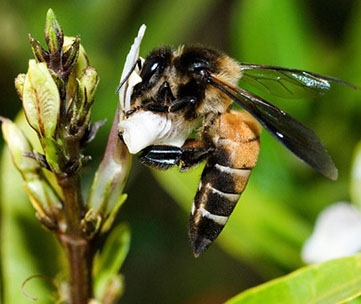
Apis dorsata, the giant honey bee, is a honey bee of South and Southeast Asia, found mainly in forested areas such as the Terai of Nepal. They are typically around 17–20 mm (0.7–0.8 in) long. Nests are mainly built in exposed places far off the ground, like on tree limbs, under cliff overhangs, and sometimes on buildings. These social bees are known for their aggressive defense strategies and vicious behavior when disturbed. Though not domesticating it, indigenous peoples have traditionally used this species as a source of honey and beeswax, a practice known as honey hunting.
Apis dorsata differs from the other bees in its genus in terms of nest design. Each colony consists of a single vertical comb made of workers’ wax suspended from above, and the comb is typically covered by a dense mass of bees in several layers. The nests vary in size, reaching up to 1 meter. Each cell within the comb is hexagonal in shape. Apis dorsata store their honey in an upper corner of the nest. The same size and type of cells are used to rear larvae. Nests are constructed in the open and in elevated locations, such as on urban buildings or tall trees. These bees rarely build nests on old or weak buildings for safety concerns. Apis dorsata can form dense aggregations at one nesting site, sometimes with up to 200 colonies in one tree.
Each colony can have up to 100,000 bees and is separated by only a few centimeters from the other colonies in an aggregation. Some colonies also exhibit patterns of nest recognition, in which they return to the same nesting sites post migration.
Picture Credit : Google




